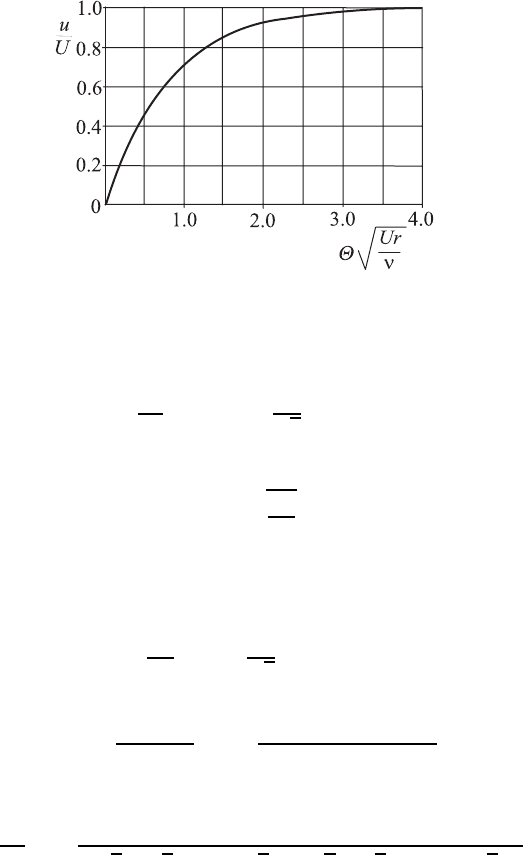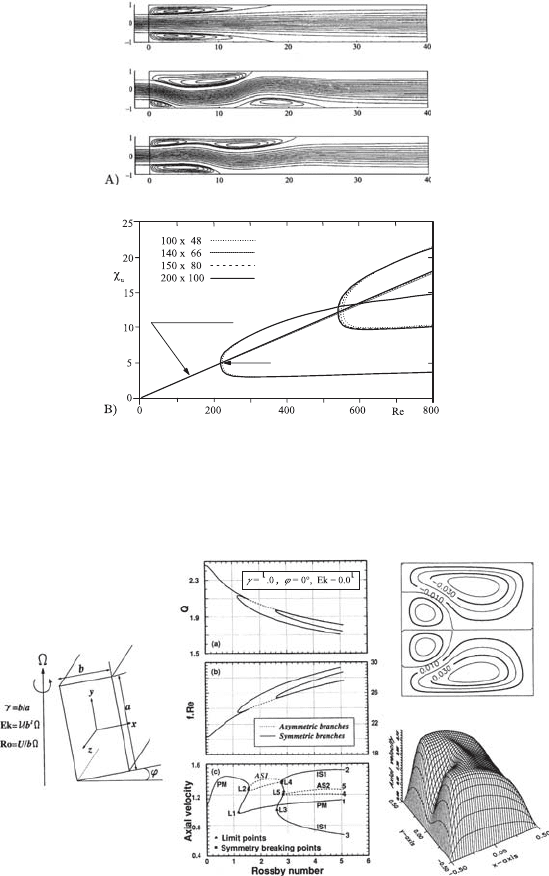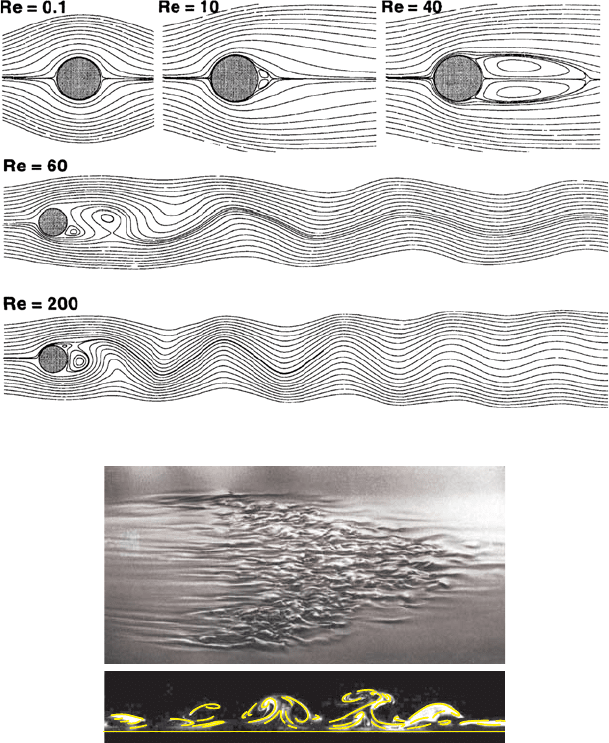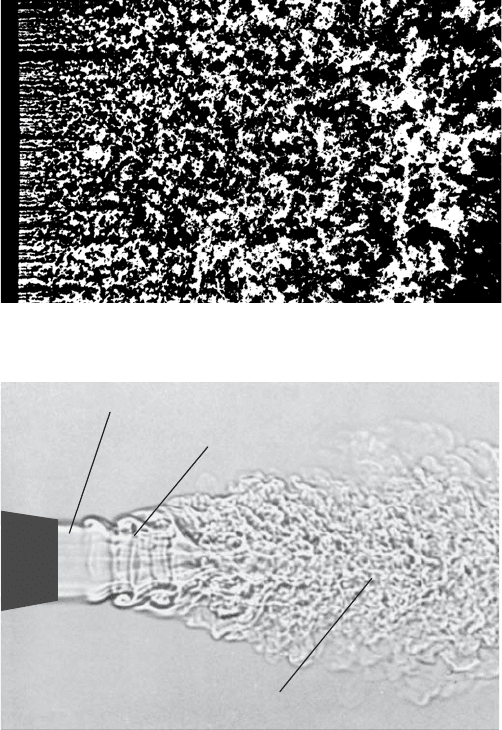Durst F. Fluid Mechanics: An Introduction to the Theory of Fluid Flows
Подождите немного. Документ загружается.


492 16 Flows of Large Reynolds Numbers
Fig. 16.15 Velocity distribution in a laminar boundary layer forming at the walls
of a converging channel
or rewritten:
f
(η)=
U
x
U
=3tanh
2
η
√
2
+1.146
− 2. (16.152)
Introducing also Θ = y/x and
˙
Q = rUα, one can rewrite η as:
η = Θ
0
Ur
ν
(16.153)
and the velocity distribution shown in Fig. 16.15 results for the boundary
layer at the walls of a converging, plane, two-dimensional channel flow.
The above-obtained relationship (16.152):
U
x
=
3
˙
Q
αx
tanh
2
η
√
2
+1.146
− 2 (16.154)
canalsobewrittenas:
tanh
2
[Z]=1−
1
cosh
2
[Z]
=1−
4
(exp[Z]+exp[−Z])
2
. (16.155)
This can be inserted to yield the velocity distribution:
U
x
=
˙
Q
αx
3
1 −
12
7
(
√
3+
√
2) exp(η/
√
2) + (
√
3 −
√
2) exp(−η/
√
2)
8
2
4
.
(16.156)
References
16.1. G. K. Batchelor: “An Introduction to Fluid Dynamics”, Cambridge University
Press, Cambridge (1967)
16.2. B. A. Boley and M. B. Friedman: On the Viscous Flow Around the Leading
Edge of a Flat Plate, JASS 26, 453–454 (1959)
References 493
16.3. G. F. Carrier and C. C. Lin: On the Nature of the Boundary Layer Near the
Leading Edge of a Flat Plate, Q. Appl. Math. VI, 63–68 (1948)
16.4. D. Pnueli and C. Gutfinger: “Fluid Mechanics”, Cambridge University Press,
Cambridge (1992)
16.5. H. Schlichting: “Boundary Layer Theory”, 6th edition, McGraw-Hill, New York
(1968)
16.6. F. S. Sherman: “Viscous Flow”, McGraw-Hill, Singapore (1990)
16.7. J. M. Shi, F. Durst and M. Breuer: Matching Asymptotic Computation of the
Viscous Flow Around the Leading Edge of a Flat Plate, in preparation.
16.8. F. Durst: “Str¨omungslehre – Einf¨uhrung in die Theorie der Str¨omungen”, 4,
Springer, Berlin Heidelberg New York (1996)
16.9. C. S. Yih: “Fluid Mechanics – A Concise Introduction to the Theory”, West
River Press, Ann Arbor, MI (1979)
Chapter 17
Unstable Flows and Laminar-Turbulent
Transition
17.1 General Considerations
It is common practice to categorize flows as laminar or turbulent, i.e. to
employ a special state of the flow to perform a subdivision: into laminar flows,
i.e. in such flows in which the momentum, heat and mass transport processes
are molecular dependent, and into such flows in which turbulence-dependent
transport processes occur in addition. For the considerations presented in
this chapter, a further subdivision is appropriate, so that grouping into four
sub-groups is made:
• Stable Laminar Flows. A laminar flow may fulfill all requirements of the
basic equations of fluid mechanics. It may also satisfy the initial and
boundary conditions characteristic for the flow. Yet it must not represent
a solution such as one finds in corresponding experimental investigations.
Disturbances of the flow, as always occur in experiments, are often not
considered in solutions of the basic equations governing fluid flows. Only
such laminar flows that prove stable towards disturbances that act from
the outside, i.e. attenuate the imposed disturbances, are defined as stable
laminar flows.
• Unstable Laminar Flows. A laminar flow is considered unstable when
disturbances introduced into it are amplified, but a certain “regularity”
in the excited disturbance is maintained, i.e. due to the disturbance
the investigated flow merges into a new laminar flow state. If this “new
laminar flow state” is stable towards newly introduced disturbances, we
have a bifurcation of the laminar flow. Here it is important to understand
that the flow occurring after the imposed disturbance can be stationary
or non-stationary.
• Transitional Flows. When the disturbances introduced in a laminar
flow are amplified and result in flows that appear orderly in parts, but
show also temporarily and/or spatially irregular fluctuations of all flow
quantities, we speak of a transitional flow state. Intermittent laminar and
495

496 17 Unstable Flows
turbulent flow states occur, i.e. phases occur in the flow in which the flow
is laminar and phases in which the flow shows turbulent characteristics.
Flows that are in a transitional state still show clear characteristics that
depend on the imposed disturbances.
• Turbulent Flows. It is now easily possible to imagine, on the basis of
the considerations presented above, that disturbances are introduced
into flows to such an extent that fluid motions result from them that
are “out of control.” Such turbulent fluctuations of all flow quantities
are superimposed on corresponding mean flow quantities and are char-
acterized by high non-stationarity and by high three-dimensionality.
Turbulence-dependent transport processes of momentum, heat and mass
are superimposed on the molecular-dependent transport process. A closed
treatment of turbulent transport processes is at present only possible for
small Reynolds numbers (Re ≤ 40,000) by employing numerical com-
putation procedures. The treatment of turbulent flows at high Reynolds
numbers remains a problem of fluid mechanics that has not been solved.
In the preceding chapters, flows were investigated that are assumed to be
stable, i.e. without concrete proof it was assumed that disturbances which are
introduced into the flow are damped out by viscosity. In order to understand
now the causes of stable laminar flows, i.e. the causes of the attenuation of
disturbances by viscosity, the simplified one-dimensional momentum equation
is considered:
ρ
∂U
1
∂t
= µ
∂
2
U
1
∂x
2
. (17.1)
When applying this to a flow with a constant flow velocity U
0
,onwhich
a disturbance with amplitude u
A
is superimposed, the following equation
applies for the total velocity field:
U
1
= U
0
+ u
A
sin
2π
x
λ
with U
0
= constant. (17.2)
On now forming the temporal derivative (∂U
1
/∂t) and the spatial derivative
(∂
2
U
1
/∂x
2
), one obtains from (17.2) the following differential equation for
the disturbance. It indicates how the temporal change of the amplitude of
the imposed fluctuations behaves in time:
du
A
dt
= −ν
4π
2
λ
2
u
A
. (17.3)
This differential equation can be solved by separation of the variables. Thus,
for the initial condition u
A
=(u
A
)
0
,forthetimet ≥ 0 the following solution
can be derived:
u
A
(t)=(u
A
)
0
exp
−ν
4π
2
λ
2
t
. (17.4)
This solution makes it clear that the viscosity terms in the momentum equa-
tions can be considered to lead to attenuations of imposed disturbances, i.e.
disturbances which are introduced into a laminar flow field will be damped
17.1 General Considerations 497
due to the viscosity of the fluid. As expressed by (17.4), the attenuation of
short-wave disturbances, i.e. disturbances with small λ values, turns out to
be stronger, so that these receive stronger damping in the course of time. It
is this attenuation effect, caused by the viscosity of a fluid, which ensures
that many laminar flows possess high stability. This means that they show
strong resistance against external disturbances.
As concerns the possible mechanisms of amplification of disturbances,
these can be manifold and some are discussed in an introductory way in sub-
sequent sections. Generally it can be said, however, that gradients of flow
and/or fluid properties can be stated as causes of amplification. When they
act on introduced disturbances such that an exponential excitation takes
place, the latter can be described as follows:
u
A
=(u
A
)
0
exp(αt). (17.5)
When a viscosity-dependent attenuation exists at the same time, the temporal
development of the amplitude of a disturbance can be stated in a simplified
way, and the following net result can be assumed to be valid:
u
A
=(u
A
)
0
exp [(α − β)t] . (17.6)
When the viscosity-dependent attenuation term β proves to be larger than
the amplification-caused term α, i.e. β>α, we have a stable laminar flow.
When, on the other hand, the amplification term α dominates, i.e. α>β,
we have an unstable flow. This means that the flow field determined from
the Navier–Stokes equations for given initial and boundary conditions will
not form in practice. Due to the above-postulated exponential increase of the
disturbance introduced into the flow, a transition into a turbulent flow is to
be expected. When the excitation takes place in another, non-exponential
form, other unstable flow states, as mentioned in the above points, can form.
To make clear now what is to be understood by a stable laminar flow state,
reference is made to the backward-facing, double-sided step flow, which is
illustrated in Fig. 17.1. It shows a symmetrical solution for Re ≤ 200. When
imposing temporal disturbances on these flows, the temporal change of the
separation lengths x
2
, shown in Fig. 17.1, indicates that, after abandoning
the imposed disturbances, the separation and reattachment lengths, that are
characteristic for the step flow, are attained again. The flow is thus, for the
investigated Reynolds number, stable towards the imposed disturbances. At
higher Reynolds numbers, i.e. for Re ≥ 200, this stability no longer exists.
The flow abandons its symmetry, and two separate regions of different lengths
and shapes occur.
For further explanations of the processes that take place with unstable
laminar flows, reference is made to the flow through a rectangular channel.
The latter is characterized by secondary flows as shown in Fig. 17.2. These
so-called secondary flows represent fluid motions in a plane vertical to the
main flow. Depending on the Reynolds number, a certain secondary flow
pattern develops as the so-called bifurcation diagram demonstrates, which

498 17 Unstable Flows
(a)
(b)
(c)
Stable flow region
Bifurcation point
Fig. 17.1 (A) Stability of double-sided step flow (sudden expansion): (a)sym-
metrical solution (unstable); (b) asymmetric solution (stable solution of the first
bifurcation); (c) asymmetric solution (unstable solution of the second bifurcation).
(B) Bifurcation diagram for a flow with sudden extension
Fig. 17.2 Pattern of the secondary flow in a rectangular channel and corresponding
bifurcation diagram
is also shown in Fig. 17.2. Detailed numerical investigations show, however,
that certain patterns of secondary flow can only be obtained by imposed
disturbances that are well directed.

17.1 General Considerations 499
Another possibility of bifurcation of an unstable laminar flow is given in
Fig. 17.3. This figure shows that the laminar flow around a cylinder posseses
a symmetry of the flow field for small Re.ForRe ≥ 46 the “symmetry” is
broken. A non-stationary vortex flow (Hopf bifurcation) develops with alter-
nating vortices relieving one another. In the wake of the cylinder, the so-called
Karman vortex street results as the form of the laminar flow around a cylinder
which proves to be a stable flow form for Re > 46.
To illustrate a transitional flow, reference is made to Fig. 17.4, in which a
region of turbulent flow is shown that is embedded in a laminar plate flow.
It can clearly be seen that the turbulence-dependent flow disturbances are
Fig. 17.3 Flow forms of the laminar flows around a cylinder
Fig. 17.4 Turbulent spot to illustrate the transitional, laminar-to-turbulent flow
state of a flow; see van Dyke [17.1]

500 17 Unstable Flows
spatially and temporally limited. Likewise, a certain, still clearly distinctive
structure of the flow can be recognized. All of these are clear characteristics
of flows that are in a transitional, laminar-to-turbulent flow state.
As a turbulent state of a flow, the photograph illustrates a grid wake
flow, which is made visible by introduced smoke. The “filaments” of smoke,
introduced near the grid, are structured by the turbulent fluid motions and
form a typical picture of an almost isotropic flow field. By isotropy of a flow a
local property is understood, namely the independence of the mean properties
of the flow of considered directions (Fig. 17.5).
That the flow states described above can occur within one flow region is
illustrated in Fig. 17.6. This figure shows an open jet coming out of a nozzle
Fig. 17.5 Turbulent grid wake flow: making turbulent flow properties visible by
introduced smoke; see van Dyke [17.1]
Laminar flow
Transitional flow
Turbulent flow
Fig. 17.6 Subsonic open jet with areas of laminar, transitional and turbulent flow;
see van Dyke [17.1]
17.2 Causes of Flow Instabilities 501
which shows laminar flow behavior in the immediate vicinity of the nozzle.
The laminar flow becomes unstable and leads to a laminar-to-turbulent tran-
sition behavior, before further downstream the flow becomes completely
turbulent. For the last-named flow region it is characteristic that no dis-
tinctively coherent flow structures can be recognized any more. This makes
it clear that the transitional flow behavior can occur in parts of flows. In
front of these transitional sub-domains the flow is laminar and behind these
domains (looked at in the flow direction) the flow is turbulent.
17.2 Causes of Flow Instabilities
Flow instabilities show features that are manifold, and there is an extensive
literature available on their causes and on the resultant flow structures that
can be observed. It shall be the task here to discuss some of the causes that
occur and the resultant flow phenomena. The chapter tries to give an in-
troduction to the considerations that have to be carried out to investigate
flow instabilities theoretically. The methods employed in the considerations
are also part of the presentations, but they are limited to selected examples.
They were chosen, however, such that they clearly illustrate the full attraction
of fluid-mechanical investigations of unstable flows. Hence, the aim of the pre-
sented material is to ensure that students of fluid mechanics receive an early
introduction to the broad (but also very specialized) field of non-stationary
flow investigations, and that they are made familiar with the available solu-
tion methods. Here, it is important always to take the below-mentioned steps
towards a solution of the posed instability problems:
(a) Determine the main flow field as an analytical or numerical solution of the
Navier–Stokes equations and for the boundary conditions determining
the flow problem.
(b) Utilize the basic equations to derive equations to treat flow disturbances.
Carry out considerations for small amplitudes of the disturbances, i.e.
use the linearized equations to compute the disturbance. In this way,
linear, partial differential equations result and have to be treated for the
disturbances of all flow quantities to be considered.
(c) Obtain solutions of the resulting linear, partial differential equation sys-
tem for given disturbances, in order to investigate the increase or decrease
in the amplitude of the disturbances in space and time.
(d) The linear, partial differential equation system can be solved, to some
extent, for the general propagations of disturbances. Solutions do not
exist for all disturbances, so that one is often forced to carry out further
simplifications. The derivation of the Orr–Sommerfeld equation results
from such a simplification.

502 17 Unstable Flows
(e) Finally, interpretations of the results obtained are needed for deciding
the ranges of parameter values for stable or unstable, laminar flows.
Steps (a)–(e) are shown in parts of the subsequent derivations.
17.2.1 Stability of Atmospheric Temperature Layers
In Chap. 6, the pressure distribution in the atmosphere was considered
for very different temperature distributions, e.g. also for the following
temperature distribution:
T (x
2
)=T
0
1 −
x
2
c
, (17.7)
which states a linear temperature decrease with increasing height above sea
level. In this relationship γ = T
0
/c is the (existing) temperature gradient:
dT
dx
2
=
T
0
c
= constant. (17.8)
For the temperature distribution in the atmosphere, given by (17.7), the
corresponding pressure distribution could be found by integration of the
following equation:
dP
dx
2
= −gρ = −
g
RT
P (17.9)
resulting in
P = P
0
1 −
x
2
c
gc
RT
0
= P
0
(T
0
− γx
2
)
g
Rγ
. (17.10)
In the considerations in Chap. 6, it was indirectly assumed that the chosen
temperature distribution is stable, i.e. introduced disturbances leave the im-
posed temperature distribution undisturbed. Here, the extent to which this
holds true will be investigated, i.e. up to what temperature layer the imposed
temperature gradient is stable.
To be able to carry out the required stability considerations, a fluid el-
ement is considered which is deflected upwards for a short time. Here the
deflection of the fluid element is considered under adiabatic conditions. When
the deflection leads to a buoyancy force on the fluid element, increasing the
induced deflection, the temperature distribution is considered to be unsta-
ble. When the deflected fluid element experiences a restoring force, which is
directed such that a reduction of the deflection takes place, we have a stable
temperature distribution in the considered atmosphere (Fig. 17.7).
Taking the temperature T
as the temperature of a fluid particle which
experiences an adiabatic upward movement from z to z +dz, the following
relationship holds under adiabatic conditions:
